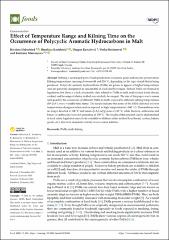Effect of Temperature Range and Kilning Time on the Occurrence of Polycyclic Aromatic Hydrocarbons in Malt

View/
Date
2023Author
Habschied, Kristina
Kartalović, Brankica
Kovačević, Dragan
Krstanović, Vinko
Mastanjević, Krešimir
Metadata
Show full item recordAbstract
Kilning is an integral part of malt production; it ensures grain and enzyme preservation.
Kilning temperatures can range between 80 and 220 C, depending on the type of malt that is being
produced. Polycyclic aromatic hydrocarbons (PAHs) are prone to appear at higher temperatures
and are generally designated as undesirable in food and beverages. Sixteen PAHs are framed in
legislation, but there is a lack of scientific data related to PAHs in malt, malt-related foods (bread,
cookies) and beverages (whisky, malted non-alcoholic beverages). The aim of this paper was to assess
and quantify the occurrence of different PAHs in malts exposed to different kilning temperatures
(50–210 ) over a variable time frame. The results indicate that some of the PAHs detected at lower
temperatures disappear when malt is exposed to high temperatures (>100 C). Phenanthrene was
no longer detected at 100 C and indeno [1,2,3-cd] pyrene at 130 C, while fluorene, anthracene and
benzo (a) anthracene were not quantified at 170 C. The results of this research can be implemented
in food safety legislation since foods available to children utilize malted flour (bread, cookies, bakery
goods, etc.) due to its enzymatic activity or as a colour additive.
